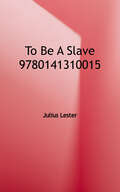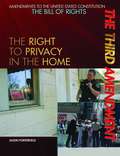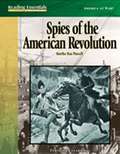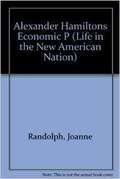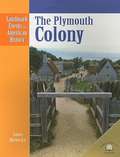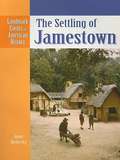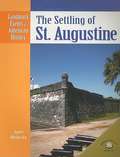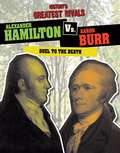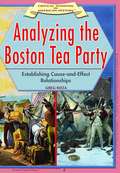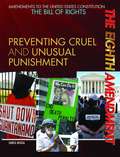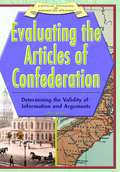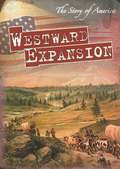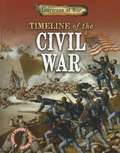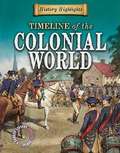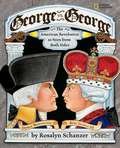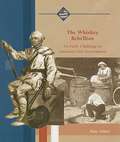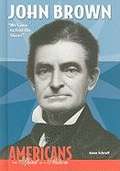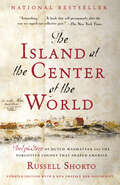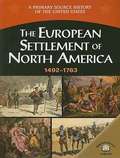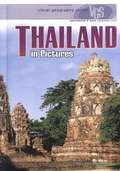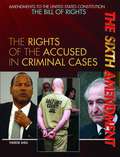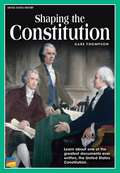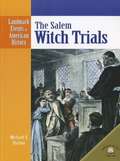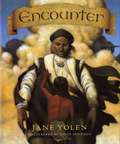Special Collections
District List: NYC Core Curriculum 7th - Social Studies
Description: The New York City Core Curriculum program aims to provide a high-quality curricula to NYC students through a seamless instructional program across grades and subjects. This list has been curated by #NYCDOE for 7th Grade Social Studies materials.
- Table View
- List View
To Be A Slave
by Julius LesterA compilation of reminiscences of slaves and ex-slaves about their lives, from those leaving Africa through the Civil War into the 20th century.
Newbery Medal Honor Book.
The Third Amendment
by Jason PorterfieldThe Third Amendment guarantees that soldiers cannot be quartered with U.S. citizens during times of peace. At the time of its passage, this amendment made a significant difference in the lives of American citizens. It formed a separation between Americas military and its civilians. Although seldom cited today in court cases, the Third Amendments impact has been long lasting, and has given rise to military bases all over the country. This book richly explores the amendment and its history. Fascinating sidebars and photographs support the text.
Spies Of The American Revolution
by Martha Sias PurcellExplains the purpose of spies during the American Revolution and describes the actions of several spies including Nathan Hale, General Benedict Arnold, Emily Geiger, and Patience Lovell Wright.
Alexander Hamilton's Economic Plan
by Ryan P. RandolphAlexander Hamilton's Economic Plan: Solving Problems in America's New Economy
The Plymouth Colony
by Janet RieheckyDescribes the establishment of the English colony at Plymouth, Massachusetts, from its planning phase to the 1620 translantic journey of settlers, as well as the experiences of those settlers in the new land.
The Settling Of Jamestown
by Janet RieheckyExamines the founding of the English colony at Jamestown, its struggle for survival, and its eventual decline.
The Settling Of St. Augustine
by Janet RieheckyTraces the history of St. Augustine, Florida, from its founding and development as a Spanish colony and military outpost in 1565 through the early eighteenth century, and discusses the impact of European colonialization on the native
Alexander Hamilton Vs. Aaron Burr
by Ellis RoxburghAlexander Hamilton and Aaron Burr came from differing backgrounds, but rose to great stature in the years following the American Revolution. As Secretary to the Treasury, Hamilton tackled the fragile finances of the new nation. Burr became the third US vice president in 1800. Readers may wonder how two such prominent men wound up in a duel that ultimately took Hamilton's life and ended Burr's political career. This is the engrossing account of the incidents that led to that fateful morning in 1804. Background information of the era, a timeline, quotes, and historical paintings enhance readers' understanding of the post-revolutionary country.
Analyzing The Boston Tea Party
by Greg RozaUsing the exercises and primary source documents in this engaging book, students will learn about key moments that led to the American Revolution.
These include the financial pressure on England after its resources were spread thin by the French and Indian War, the formation of the Sons of Liberty, the backlash and revolt of colonists in response to the Stamp, Sugar, and Quartering Acts, the tea party itself, and the eventual meeting of the first Continental Congress.
The Eighth Amendment
by Greg RozaPrior to the existence of the Eighth Amendment, there was little to protect citizens of the English colonies from excessive bail, excessive fines, and cruel and unusual punishments. The enduring freedoms guaranteed by this amendment are extremely important to all U.S. citizens. Readers will learn about the politicians who fought for the amendment's passage. They will also learn about what life was like for Americans before the Eighth Amendment was passed, how the amendment's elastic wording has helped it remain relevant through the years, and how it defends our freedoms today.
Evaluating the Articles of Confederation
by Greg RozaThis is a fascinating look at the state of the nation at the time of the drafting of the Articles of Confederation seen against the backdrop of revolution, the various ideological debates and practical considerations that shaped it, and the document's inherent weaknesses that necessitated its replacement with the Constitution.
Westward Expansion
by Greg RozaThere were many reasons for Americans to move west in the 1800s. The gold rush, religious movements, new farmland, and even a transcontinental railroad brought people from across the country to settle.
This book highlights the major causes and effects of Americas push westwardfrom the Erie Canal to the rise of cowboys. With the help of detailed photographs, readers discover the events that expanded America from the Atlantic Ocean to the Pacific Ocean.
Timeline Of The Civil War
by Charlie SamuelsPresents a timeline of the Civil War, including causes of the conflict, the life of soldiers on both sides, and the end of the war.
A Timeline of the Colonial World
by Charlie SamuelsChronicles the important events, people, and locations during the Colonial era, including the age of exploration, the settling of North America, the American Revolution, and the colonization of Australia and Africa.
George vs. George
by Rosalyn SchanzerThere are two sides to every story. Rosalyn Schanzer's engaging and wonderfully illustrated book brings to life both sides of the American Revolution. The narrative introduces anew the two enemies, both named George: George Washington, the man who freed the American colonies from the British, and George III, the British king who lost them. Two leaders on different sides of the Atlantic, yet with more in common than we sometimes acknowledge. We are lead through their story, and the story of their times, and see both sides of the arguments that divided the colonies from the Kingdom. Was King George a "Royal Brute" as American patriots claimed? Or was he, as others believed, "the father of the people?" Was George Washington a scurrilous traitor, as all the king's supporters claimed? Or should we remember and celebrate him as "the father of his country?" Who was right? History teaches us that there are two sides to every story. Rosalyn Schanzer's book is an accessible account of one the most vital periods in American history. It is also a timeless lesson in seeing history from different points of view. The author spent two years researching books, paintings, cartoons, and descriptions of Revolutionary times. She uses art, text, and first-hand accounts to illustrate how history should never be reduced to simplistic conflicts between the "good guys" and the "bad guys. " Her illustrations, and her engaging quote bubbles, bring the Revolution to life again, and allow the characters of the period to speak for themselves. Through its lively text, detailed illustrations, and fully authenticated quotes, George vs. George shines fresh light on both sides of the story of our country's formative years.
The Whiskey Rebellion
by Katy SchielWhen Congress enacted a 25 percent excise tax on domestically produced distilled spirits, grain growers and distillers were irate. Especially upset were the small producers of alcohol who began to organize an opposition. When mobs organized an opposition, a tax collector was tarred and feathered and another had his home burned. Shots were exchanged. President Washington called upon the rebels to disperse, but his pleas were ignored. A force of nearly 13,000 men was raised and quelled the opposition, which quickly faded away.
John Brown
by Anne E. SchraffThis story will captivate and inspire your readers. John Brown hated slavery. On October 16, 1859, he and his armed followers took a violent stand against it. John Brown led his raiding party to the armory in Harpers Ferry, Virginia, with the intent of inciting slave rebellions throughout the South. However, within two days, ten of his men would be killed and Brown was arrested. Although the Harpers Ferry raid failed, John Brown had struck a blow against slavery. A staunch abolitionist his entire life, John Brown gave his life to end an evil that had existed in the United States for over two hundred years.
The Island at the Center of the World
by Russell ShortoIn a riveting, groundbreaking narrative, Russell Shorto tells the story of New Netherland, the Dutch colony which pre-dated the Pilgrims and established ideals of tolerance and individual rights that shaped American history. "Astonishing . . . A book that will permanently alter the way we regard our collective past." --The New York Times When the British wrested New Amsterdam from the Dutch in 1664, the truth about its thriving, polyglot society began to disappear into myths about an island purchased for 24 dollars and a cartoonish peg-legged governor. But the story of the Dutch colony of New Netherland was merely lost, not destroyed: 12,000 pages of its records–recently declared a national treasure–are now being translated. Russell Shorto draws on this remarkable archive in The Island at the Center of the World, which has been hailed by The New York Times as &“a book that will permanently alter the way we regard our collective past.&” The Dutch colony pre-dated the &“original&” thirteen colonies, yet it seems strikingly familiar. Its capital was cosmopolitan and multi-ethnic, and its citizens valued free trade, individual rights, and religious freedom. Their champion was a progressive, young lawyer named Adriaen van der Donck, who emerges in these pages as a forgotten American patriot and whose political vision brought him into conflict with Peter Stuyvesant, the autocratic director of the Dutch colony. The struggle between these two strong-willed men laid the foundation for New York City and helped shape American culture. The Island at the Center of the World uncovers a lost world and offers a surprising new perspective on our own.
The European Settlement Of North America (1492-1754)
by George Edward StanleyFulfill the need to incorporate primary sources in your American history reports and projects with this engaging series. Each book uses a variety of primary source documents to provide a unique perspective on historical events.
Public documents, including newspaper articles, speeches, historic acts of legislation, and treaties give readers a broader understanding of the events that shaped our nation, while personal diaries and letters provide intimate portraits of the people who influenced or witnessed those events. Featuring words drawn straight from the shapers of history, this captivating series gives readers a richer understanding of the nation's history.
Thailand in Pictures
by Stacy Taus-BolstadDescribes the geography, history, government, economy, people, and cultural life of Thailand.
Sixth Amendment
by Therese SheaOne of the hallmarks of the American criminal justice system is the right of all people accused of a crime to defend themselves in a speedy, public trial. According to the Sixth Amendment, individuals accused of crimes have a number of important rights, including: the right to a jury of their peers, the right to be informed of the charges against them, the right to an attorney and witnesses in their defense, and the right to face their accuser.
This book reviews the history of the Sixth Amendment, including the events that inspired it and the major Supreme Court cases related to it. In a concise and interesting way, the author explains the unalienable rights that are at the heart of our justice system.
Shaping the Constitution
by Gare ThompsonFind out about the ideas in the United States Constitution and the men who helped create it.
Encounter
by Jane YolenWhen Christopher Columbus landed on the island of San Salvador in 1492, what he discovered were the Taino Indians. Told from a young Taino boy's point of view, this is a story of how the boy tried to warn his people against welcoming the strangers, who seemed more interested in golden ornaments than friendship. Years later the boy, now an old man, looks back at the destruction of his people and their culture by the colonizers.
